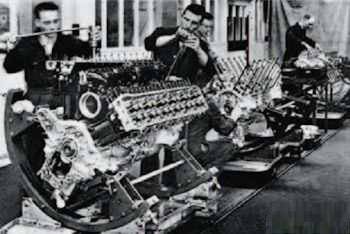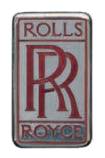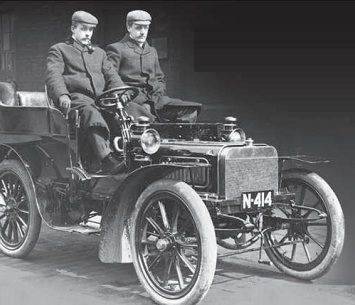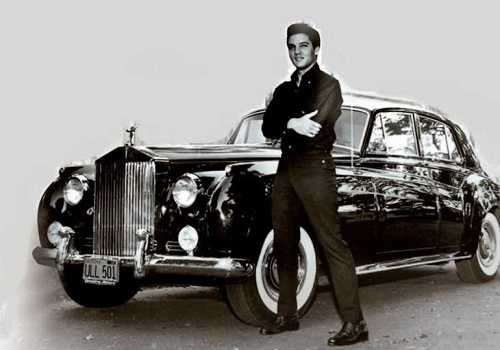FREDERICK HENRY ROYCE, founder of an electrical engineering business in Manchester, built his first car in 1904. At around the same time, Charles Stewart Rolls was setting up a motor dealership and repair workshop in London with Claude Johnson. Henry Edmunds, a friend of Rolls and a director of Royce’s company, persuaded Rolls to meet Royce and drive the new car. Rolls immediately recognized the superior quality and refinement of the vehicle. The pair agreed that Royce would develop a range of cars that Rolls would sell under the Rolls-Royce name.

Assembling Merlin engines
Assembling Merlin engines The Rolls-Royce Merlin was one of World War II’s most successful airplane engines. It was used in planes such as the Supermarine Spitfire and Hawker Hurricane.
The first models ranged from a two-cylinder, 10 hp chassis at £395, through three-cylinder 15 hp and four-cylinder 20 hp machines to a flagship 30 hp six-cylinder car, which went on sale in 1905 at £890. As with other prestige marques of the time, the body had to be purchased separately from a coachbuilder, at an additional cost of up to £500. In September 1905 Charles Rolls entered a pair of 20 hp Rolls-Royces into the Isle of Man Tourist Trophy (TT), an event that aimed to find the best touring car rather than the fastest purpose-built racing machine.
The regulations stipulated four-seater bodywork, and there was a limit on the amount of fuel the cars could use. The TT Rolls-Royces had lightweight chassis and four-speed gearboxes with overdrive top gear, allowing fast cruising with good fuel economy. Rolls drove one car, which broke its gearbox early on. The other car, in Percy Northey’s hands, finished second, gaining valuable publicity for the fledgling marque.
A 40/50 hp model, with a larger, six-cylinder engine and a revised chassis, was launched at the London Motor Show in 1906. The following year, driver Claude Johnson-who has been described as “the hyphen in Rolls-Royce”-completed a 15,000-mile (24,000-km) trial in this car under the supervision of the Royal Automobile Club (RAC). The run took in the Scottish Reliability Trial, in which the car won a gold medal. Johnson’s 40/50 was given the name Silver Ghost, after its then unusual color.

This performance, together with the Phantom series of cars introduced in 1925, enhanced the company’s growing reputation. In 1930 Rolls-Royce bought Bentley and relocated production to the Rolls-Royce works in Derby. It then developed a new range of “Derby Bentleys,” using Rolls-Royce chassis and Bentley engines. The first Rolls-Royce aircraft engines were made in World War I, and the company remained an important supplier to Britain’s fighting aircraft in World War II.
A factory was set up at Crewe, 50 miles (80 km) from Derby, to increase aircraft-engine production, and all car making moved there after the war. Post-war production began in 1946 with the Mark VI Bentley and the Rolls-Royce Silver Wraith. Both had the same new chassis and an “F-head” engine with overhead inlet valves for more efficient breathing.
This performance, together with the Phantom series of cars introduced in 1925, enhanced the company’s growing reputation. In 1930 Rolls-Royce bought Bentley and relocated production to the Rolls-Royce works in Derby. It then developed a new range of “Derby Bentleys,” using Rolls-Royce chassis and Bentley engines. The first Rolls-Royce aircraft engines were made in World War I, and the company remained an important supplier to Britain’s fighting aircraft in World War II.
A factory was set up at Crewe, 50 miles (80 km) from Derby, to increase aircraft-engine production, and all car making moved there after the war. Post-war production began in 1946 with the Mark VI Bentley and the Rolls-Royce Silver Wraith. Both had the same new chassis and an “F-head” engine with overhead inlet valves for more efficient breathing.

First Bentley, then Rolls-Royce, adopted standardized bodywork built in-house, although customers could still choose to order a bare chassis to be clothed by a coachbuilder. Bentleys were gradually reduced to little more than Rolls-Royces with Bentley radiator grilles. In 1959 a V8 engine of 6,230 cc was introduced in the Silver Cloud II and a new full-size sedan, the Phantom V. The key development of the 1960s was the 1965 Silver Shadow sedan (and its Bentley T-series brother).
A more modern car with full-width, four-door styling and a monocoque structure, the Shadow sold in greater numbers than any previous Rolls-Royce. Shadow derivatives included the two-door Corniche coupé and convertible, the long-wheelbase Silver Wraith, and the Pininfarina-designed Camargue. Updated with a 6,750 cc engine in 1970 and a host of detail improvements in 1977, the Silver Shadow remained in production until 1980, when the Silver Spirit and long-wheelbase Silver Spur (and Bentley Mulsanne) took over. Crippled by the costs of developing the RB211 aircraft engine, Rolls-Royce was taken into state ownership in 1971.
The car division was sold off as a separate entity, Rolls-Royce Motors, in 1973. The rights to the Rolls-Royce name remained with the aero-engine company, but were licensed to the car maker. In 1980 the British engineering group Vickers bought Rolls-Royce Motors. Bentleys now started to diverge from their Rolls-Royce counterparts, with the launch of the Mulsanne Turbo.
In 1998 a new range of cars, the Rolls-Royce Silver Seraph and Bentley Arnage, were for the first time powered by bought-in engines, supplied by BMW. In 1998 Volkswagen acquired Rolls-Royce and Bentley from Vickers, paying £430m for the car designs, the factory, the brand names, and the two Rolls-Royce trademarks-the Spirit of Ecstasy mascot and the “Grecian” radiator grille.

However, Volkswagen neglected to acquire the rights to use the Rolls-Royce name on cars, which were still owned by the aero-engine company. BMW bought the license to those rights for just £40m, leaving Volkswagen little option but to give up the Rolls-Royce brand and concentrate on Bentley-claiming that was all it ever wanted.
In 2003 BMW opened a new Rolls-Royce factory at Goodwood, Sussex, where production began of the new Phantom. That was joined in 2010 by a smaller model, the Ghost. The automotive media praised both cars, giving Rolls-Royce a stable start to its latest era of making what some still argue are the best cars in the world.